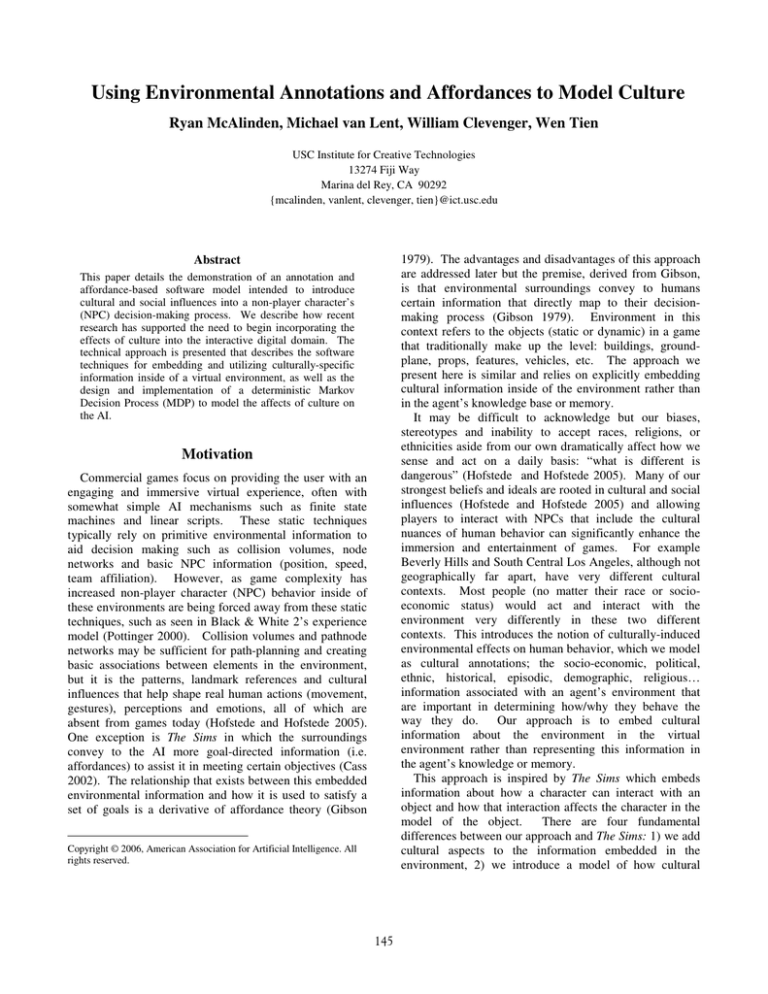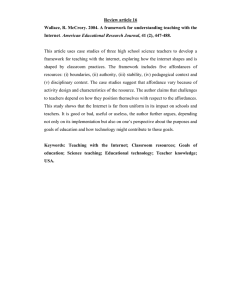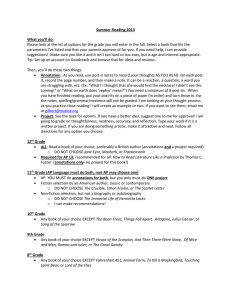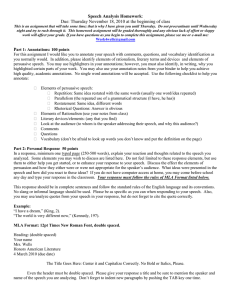
Using Environmental Annotations and Affordances to Model Culture
Ryan McAlinden, Michael van Lent, William Clevenger, Wen Tien
USC Institute for Creative Technologies
13274 Fiji Way
Marina del Rey, CA 90292
{mcalinden, vanlent, clevenger, tien}@ict.usc.edu
1979). The advantages and disadvantages of this approach
are addressed later but the premise, derived from Gibson,
is that environmental surroundings convey to humans
certain information that directly map to their decisionmaking process (Gibson 1979). Environment in this
context refers to the objects (static or dynamic) in a game
that traditionally make up the level: buildings, groundplane, props, features, vehicles, etc. The approach we
present here is similar and relies on explicitly embedding
cultural information inside of the environment rather than
in the agent’s knowledge base or memory.
It may be difficult to acknowledge but our biases,
stereotypes and inability to accept races, religions, or
ethnicities aside from our own dramatically affect how we
sense and act on a daily basis: “what is different is
dangerous” (Hofstede and Hofstede 2005). Many of our
strongest beliefs and ideals are rooted in cultural and social
influences (Hofstede and Hofstede 2005) and allowing
players to interact with NPCs that include the cultural
nuances of human behavior can significantly enhance the
immersion and entertainment of games. For example
Beverly Hills and South Central Los Angeles, although not
geographically far apart, have very different cultural
contexts. Most people (no matter their race or socioeconomic status) would act and interact with the
environment very differently in these two different
contexts. This introduces the notion of culturally-induced
environmental effects on human behavior, which we model
as cultural annotations; the socio-economic, political,
ethnic, historical, episodic, demographic, religious…
information associated with an agent’s environment that
are important in determining how/why they behave the
way they do.
Our approach is to embed cultural
information about the environment in the virtual
environment rather than representing this information in
the agent’s knowledge or memory.
This approach is inspired by The Sims which embeds
information about how a character can interact with an
object and how that interaction affects the character in the
model of the object.
There are four fundamental
differences between our approach and The Sims: 1) we add
cultural aspects to the information embedded in the
environment, 2) we introduce a model of how cultural
Abstract
This paper details the demonstration of an annotation and
affordance-based software model intended to introduce
cultural and social influences into a non-player character’s
(NPC) decision-making process. We describe how recent
research has supported the need to begin incorporating the
effects of culture into the interactive digital domain. The
technical approach is presented that describes the software
techniques for embedding and utilizing culturally-specific
information inside of a virtual environment, as well as the
design and implementation of a deterministic Markov
Decision Process (MDP) to model the affects of culture on
the AI.
Motivation
Commercial games focus on providing the user with an
engaging and immersive virtual experience, often with
somewhat simple AI mechanisms such as finite state
machines and linear scripts. These static techniques
typically rely on primitive environmental information to
aid decision making such as collision volumes, node
networks and basic NPC information (position, speed,
team affiliation). However, as game complexity has
increased non-player character (NPC) behavior inside of
these environments are being forced away from these static
techniques, such as seen in Black & White 2’s experience
model (Pottinger 2000). Collision volumes and pathnode
networks may be sufficient for path-planning and creating
basic associations between elements in the environment,
but it is the patterns, landmark references and cultural
influences that help shape real human actions (movement,
gestures), perceptions and emotions, all of which are
absent from games today (Hofstede and Hofstede 2005).
One exception is The Sims in which the surroundings
convey to the AI more goal-directed information (i.e.
affordances) to assist it in meeting certain objectives (Cass
2002). The relationship that exists between this embedded
environmental information and how it is used to satisfy a
set of goals is a derivative of affordance theory (Gibson
Copyright © 2006, American Association for Artificial Intelligence. All
rights reserved.
145
addition to these cultural attributes, environmental objects
have associated with them traditional annotations and
affordances as is seen in The Sims such as what type a
building is (bank, post office) and what they afford an
agent (hasMoney(), mailLetter()).
This markup process is performed during the
construction of the environment in a 3D authoring tool
such as Maya. An artist or modeler launches the “Tagger”
tool and selects existing groups of geometry (e.g.
buildings) to classify with individual annotations or
affordances. Once each of the objects has been annotated,
the vertices of the ground-plane are “painted” in Maya,
with each color representing a regional cultural attribute
(e.g. a neighborhood with a particular religious affiliation).
Once tagged, the environment is exported to the virtual
environment where the information is then exposed to the
underlying game engine (in our case Unreal Engine v2.5).
All of this embedded information is explicitly represented
in the terrain models (i.e. static meshes) and are
sensed/accessed by the agents through subscription
channels. This approach allows any AI system with an I/O
mechanism to integrate these object and regional
annotations with relative ease. We have prototyped an
initial AI system using an MDP that incorporates both the
agent’s and environment’s cultural attributes to alter its
decision-making.
The response to this system has been primarily voiced
by content creators of the terrain/level (artists) and AI
developers. The Tagger tool was well-received and does
not present an undue burden on the artist creating the level.
The AI developer has found that once the culture model
was represented in code, there was extensive variability
possible in entity behaviors simply by throttling the
probabilities of the transition table and/or dynamically
modifying the embedded annotations and affordances of
the environment. An area of future work includes
engineering a POMDP solution that incorporates
observational uncertainty and is more representative of the
way humans actually perceive their environment.
information affects behavior, 3) we embed information not
only in individual objects but in ground regions, and 4) we
add the ability to modify cultural parameters to increase
the variability of NPC actions.
Another unique feature of this approach is the support
for dynamic annotations and affordances that can be
modified during runtime. This adds to the environment
(and in-turn the agent) the notion of events or history that
may alter the AI’s behavior. For example, if a faction of
AI agents from one political affiliation overtakes an area of
town that was previously controlled by another political
affiliation the regional annotation for these areas can
dynamically be recalculated including storing the previous
annotation. This allows episodic or historical information
to be embedded in the environment that can then be
incorporated into the AI’s decision-making. Similar
support for singular annotations is also possible (e.g. a
bank that has just been robbed emits a HasCrime()
affordance that is broadcast to police officers).
There are several implications, both positive and
negative, for embedding annotations and affordances in the
environment versus directly in the AI’s memory. One
advantage is that the knowledge is represented and stored
in a format that is independent of any single AI system or
agent. This allows use of the information by many systems
and does not require each agent to have a separate copy of
the cultural context of the environment in memory. A
second advantage is authoring. It is easier, and requires
less programming skill, to add to a 3D environment
cultural annotations and affordances on objects and regions
of the ground. Lastly, dynamic annotations and affordances
support an environment that is episodic and historical, and
agents can use that information to maintain a sense of
history without being forced to keep all of that information
in local memory. However, there are a couple of
disadvantages to embedding culture within the
environment. One is that it increases the sensing “cost” by
agents, which directly results in higher required throughput
between the game and AI. A second disadvantage is that
agents are still required to know how to react to the
cultural information (i.e. once the cultural descriptors are
sent to the AI they must do something with them) which
still requires some (perhaps a great deal) of culturallyrelated information to be stored in the agent. We have
prototyped an example of such an AI system in the context
of a Markov Decision Process (MDP) but understanding
how the cultural annotations affect behavior could
certainly be a very large challenge.
References
Gibson, J.J. 1979. The ecological approach to visual
perception. Boston: Houghton Mifflin
Hofstede, G., & Hofstede, G.J. 2005. Cultures and
Organizations: Software of the Mind. McGraw-Hill.
Cass, S. 2002. Mind Games. IEEE Spectrum, Vol 39 (12),
40-44.
http://ieeexplore.ieee.org/iel5/6/23652/01088444.pdf?arnu
mber=1088444
Technical Approach
The first step in embedding culture within the AI is to
markup the environment. This is accomplished by an artist
or modeler “tagging” the level (i.e. buildings, props,
ground-plane) with cultural annotations. For example,
regions may be drawn and buildings marked to delineate
higher vs lower socio-economic neighborhoods.
In
Pottinger, D. The future of game AI. Aug 2000. Game
Develop. Mag. Vol 7 (8), 36–39.
146







